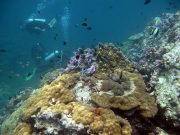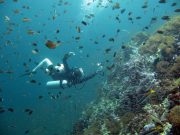Shark Point & Anemone Reef Diving
Hin Musang Wildlife Reserve
Shark Point and Anemone Reef are two of the most celebrated dive sites in the Andaman Sea. Just a 50 - 60 minute boat trip from Koh Lanta. These sites are renowned for their vibrant marine ecosystems and breathtaking underwater scenery.
Shark Point gets its name from the original shark-fin shaped rock protruding from the sea, and is a series of submerged pinnacles adorned with colourful corals and sea fans. This site is teeming with diverse marine life, including schools of snappers, fusiliers, and an array of macro life like nudibranchs and ghost pipefish.

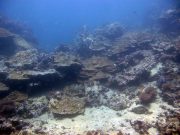

Anemone Reef is famous for its stunning carpet of anemones swaying in the currents, providing a haven for clownfish and other reef inhabitants. The reef's rich biodiversity includes sea fans, barracudas, moray eels, and seahorses.
Shark Point and Anemone Reef are part of the Hin Musang Wildlife Reserve, a marine protected area founded in 1992. This area now also includes the infamous King Cruiser car ferry which hit Anemone Reef on 4 May 1997 and sank a few hundred metres away.
On a day with good visibility, Shark Point and Anemone Reef can rank as some of the top dive sites in Thailand, however conditions can be variable and we don't recommend these dive sites for beginner divers.
Shark Point Marine Life
Hin Musang Wildlife
Shark Point, also known locally as Hin Musang, is located approximately midway between Phi Phi and Phuket.
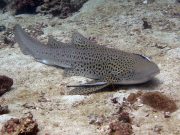

The site’s healthy coral reefs and nutrient-rich waters attract a wide variety of marine species, making it one of the top dive sites in the region.
Hard & Soft Corals
The corals at Shark Point are among the most diverse and vibrant in the Andaman Sea. The pinnacles are adorned with a mix of hard corals, such as staghorn, brain, and honeycomb corals, as well as soft corals, sea fans, and whip corals.
The deeper parts of Shark Point are home to gardens of colourful giant gorgonian sea fans, feeding on the nutrient-rich currents which pass by several times a day.
The bubble corals around Shark Point are a favourite food for sea turtles, and lucky divers might spot a critically endangered Hawksbill turtle munching on them.
The sandy areas and reef edge are littered with hundreds of mushroom corals, which prefer a more solitary existence.
These coral formations provide essential habitat for a multitude of marine species, including colourful reef fish, invertebrates, and crustaceans.
Reef Fish
Shark Point is home to an abundance of reef fish, making it a paradise for divers and underwater photographers.
Common species include butterflyfish, goatfishes, lizardfish, angelfish, grouper, parrotfish, boxfish, squirrel and soldierfish, filefish, pufferfish, and damselfish, all of which contribute to the site’s vibrant underwater scene.
Together with seahorses, ghost pipefish, and many smaller species, the high levels of nutrients in the waters attract a huge variety of marine life, making Shark Point one of the most interesting dive sites in this area.
Leopard Sharks
One of the highlights of diving at Shark Point is the chance to encounter leopard sharks, which are often seen resting on the sandy bottom near the pinnacles.
These sharks, with their distinctive spotted patterns and long tails, are generally calm and approachable, making them a favourite subject for underwater photographers.
Leopard shark sightings are not guaranteed on every dive, and they can get annoyed when divers get too close, so please take care not to crowd these graceful creatures.
Other Marine Life
In addition to leopard sharks, divers at Shark Point may encounter a variety of other marine species, including moray eels, octopuses, cuttlefish, blue-spotted stingrays, and the occasional turtle.
The site is also known for its rich macro life, with numerous nudibranchs, harlequin shrimp, ghost pipefish, and crabs hiding among the corals and rocks.
It's not unknown for larger pelagic species such as whale sharks to be spotted at Shark Point, adding an extra element of excitement to the dive.
Exploring Shark Point
Diving Shark Point from Koh Lanta
Shark Point consists of three pinnacles running roughly north to south, with the largest pinnacle to the north breaking the surface and supporting a light beacon to warn passing ships of danger.
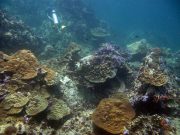
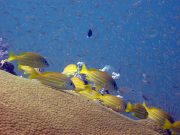
The pinnacles are covered with Gorgonian sea fans, sponges, and thousands of pink and purple soft corals.
It's best to dive this site when surface conditions are good, avoiding times of the month when stronger currents sometimes run in this area.
Shark Point: The Pinnacles
A typical dive at Shark Point begins with a descent along the main pinnacle which breaches the surface. Divers can explore the coral-covered walls and the numerous cracks and crevices that provide hiding spots for marine life.
A short swim south from the first pinnacle at around 18m will bring you to the second pinnacle.
The third pinnacle lies slightly further south in deeper waters and is rarely dived due to the shorter dive times at this depth. As with many dive sites, conditions can be variable and it's more suitable for experienced divers than beginners.
The pinnacles are home to a variety of reef fish, and divers can expect to see schools of snappers, fusiliers, barracuda, and trevallies swirling around the coral formations.
The deeper sections of the pinnacles often harbour leopard sharks, which can be seen resting on the sandy bottom.
Shark Point: Coral Gardens
As you explore the pinnacles at Shark Point, you’ll come across sections of lush coral gardens that are teeming with life.
These gardens are home to a variety of hard and soft corals, barrel sponges, and sea fans, which attract numerous species of reef fish and invertebrates.
The vibrant colours and intricate structures of the corals make this part of the dive particularly captivating.
Divers can spend time slowly exploring these gardens, observing the interactions between the different species that call this reef home.
Shark Point: Leopard Shark Encounters
One of the highlights of diving at Shark Point is the opportunity to see leopard sharks up close. These graceful creatures are often found resting on the sandy bottom near the pinnacles, making them relatively easy to spot.
If you’re lucky enough to encounter a leopard shark during your dive, take the time to observe it from a respectful distance, and you may be rewarded with a close-up view of one of the ocean’s most beautiful sharks.
Shark Point: Dive Site Guide
- NameShark Point
- Visibility5m - 20m +
- Level of DivingMedium
- SnorkelingNo
- Depth3m - 30m +
- CurrentsMedium to Strong
- Journey Time50 - 60 mins

Book online to save 10% on dive trips and scuba courses on Koh Lanta.
Anemone Reef Marine Life
Hin Musang Wildlife Reserve
Anemone Reef is renowned for its stunning marine biodiversity, with the many thousands of carpet anemones providing a unique environment that supports a wide variety of species.
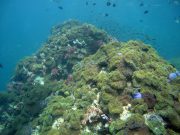
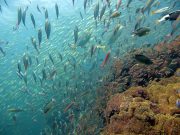
The site’s protected status within the Shark Point Marine Sanctuary helps to preserve its rich ecosystem.
Sea Anemones
The defining feature of Anemone Reef is the vast expanse of carpet anemones that cover the pinnacle.
These anemones provide shelter for a variety of marine life, most notably the iconic clownfish, which can be seen darting in and out of the anemones.
The anemones themselves are a sight to behold, with their delicate tentacles creating a flowing, almost hypnotic effect as they move with the current.
The presence of so many anemones in one place makes Anemone Reef a truly unique dive site.
Reef Fish
Like Shark Point, Anemone Reef is home to an abundance of reef fish. The pinnacle is teeming with species such as butterflyfish, angelfish, barracuda, emperors, wrasse, lionfish and scorpionfish, all of which add to the site’s vibrant underwater environment.
Schools of snappers, fusiliers, and trevallies are often seen swarming around the pinnacle, creating a dynamic and ever-changing scene.
The smaller crevices and cracks in the reef are home to moray eels, sea horses, and various species of blennies and gobies.
Macro Life
Anemone Reef is also a paradise for macro photographers and those who enjoy observing the smaller inhabitants of the reef.
The anemones and corals provide shelter for a variety of nudibranchs, crabs, lobsters, shrimps, and other invertebrates.
These tiny creatures are often well-camouflaged, but with a keen eye, divers can spot an array of fascinating and colourful species.
The site’s rich macro life makes it an excellent spot for those who enjoy searching for and photographing the smaller, more intricate creatures of the underwater world.
Exploring Anemone Reef
Diving Anemone Reef from Koh Lanta
Anemone Reef, known locally as Hin Jom, is located about 500 metres north of Shark Point and is often visited as part of the same dive trip.
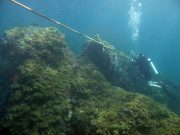
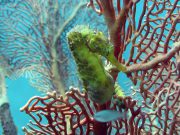
Unlike Shark Point, which features multiple pinnacles, Anemone Reef is a single large rock formation starting around 4m and sloping down onto the sandy seabed at around 26 metres.
Covered with countless thousands of anemones feeding on the currents, sea fans, soft corals, and glassfish often cover large parts of this reef.
Anemone Reef: The Anemone Fields
The highlight of diving at Anemone Reef is undoubtedly the vast fields of carpet anemones that cover the pinnacle.
As you descend, you’ll be greeted by the sight of thousands of anemones swaying gently in the current, creating a mesmerising and almost otherworldly scene.
The anemones are home to thousands of clownfish, which can be seen darting in and out of the tentacles as they go about their daily activities.
The abundance of anemones and clownfish makes this part of the dive particularly memorable, and it’s a great spot for underwater photography.
Anemone Reef: Coral Gardens
After exploring the anemone fields, divers can continue to explore the rest of the pinnacle, which is covered in a mix of hard and soft corals, sponges, and huge sea fans.
The reef is teeming with life, and divers can expect to see a wide variety of reef fish, including butterflyfish, angelfish, parrotfish and sea snakes.
The deeper sections of the reef offer the chance to see larger species such as barracudas, jackfish, rainbow runners, and trevallies, while the shallower areas are ideal for macro photography and observing the smaller inhabitants of the reef.
Anemone Reef: Currents and Conditions
Like Shark Point, the currents at Anemone Reef can vary depending on the time of day and tidal conditions.
The currents are generally mild but can become stronger at certain times, particularly around the base of the pinnacle. It’s important to monitor the current conditions before diving and to plan the dive accordingly.
Anemone Reef is a great site for a relaxed and leisurely dive, but it can also offer more challenging conditions for those looking for an adventure.
Anemone Reef: Dive Site Guide
- NameAnemone Reef
- Visibility5m - 25m +
- Level of DivingMedium
- SnorkelingNo
- Depth3m - 20m +
- CurrentsMedium to Strong
- Journey Time50 - 60 mins

Book online to save 10% on dive trips and scuba courses on Koh Lanta.
Shark Point & Anemone Reef Diving Price
Koh Lanta Dive Trips
Fun Diving price at Shark Point & Anemone Reef is ฿3,950 for 2 dives. Diving price includes dive guide, free equipment rental, lunch & soft drinks on the boat when booked online in advance.
- 2 Dives
- FREE Equipment Rental
- Dive Guide
- Lunch & Soft Drinks
- 2 Dives
- FREE Equipment Rental
- Dive Guide
- Lunch & Soft Drinks
- You must be certified minimum SSI/PADI Open Water Diver, CMAS 1 Star Diver, BSAC Ocean Diver, or equivalent.
- Does not include Marine Park Diving Fee: Thai ฿240, Foreigner ฿600, per day.
See a complete list of all our Koh Lanta Diving Prices.
Book online to save 10% on dive trips and scuba courses on Koh Lanta.
Coral Reef Conservation
Protecting marine life at Shark Point & Anemone Reef
Shark Point & Anemone Reef are part of the Hin Musang Wildlife Reserve, a marine protected area. This status helps preserve the underwater ecosystem at Shark Point & Anemone Reef, and ensures sustainable tourism practices.
Divers visiting Shark Point & Anemone Reef are encouraged to follow guidelines that minimise their impact on the environment
Responsible Diving Practices
To protect the delicate marine environment, divers are urged to follow responsible diving practices, including:
- Avoid touching or disturbing marine life while diving at Shark Point & Anemone Reef: Many marine organisms are delicate and can be harmed by human contact.
- Practice good buoyancy control while diving at Shark Point & Anemone Reef: Maintaining proper buoyancy helps prevent accidental damage to corals and other marine life.
- Do not collect souvenirs from Shark Point & Anemone Reef: Removing shells, corals, or other marine life from the sea is illegal and harmful to the ecosystem.
- Dispose of waste properly: Do not throw any rubbish or food into the sea, especially at the dive site. Throwing food into the water at a coral reef interferes with the delicate marine eco-system.
- Use Reef Safe Sun Block: Ensure your sunscreen is Reef Safe and does not harm the corals and marine life at Shark Point & Anemone Reef.
Koh Lanta Dive Sites
Some of Thailand's Best Diving
Shark Point & Anemone Reef are some of the best dive sites in Thailand, and can be easily dived from Koh Lanta by speedboat along with many of Thailand's other top dive sites:
- Lanta Marine Park
- Koh Haa Islands
- Koh Rok Islands
- Hin Daeng & Hin Muang
- Hin Musang Wildlife Reserve
- Shark Point & Anemone Reef
- Phi Phi Marine Park
- Bida Nok & Bida Nai
- Hin Bida
- Koh Phi Phi
- HTMS Kledkaeo Wreck
- Hin Klai
Find out more at the Thai Department of National Parks.
Our Dive Trip Schedule
Lanta Dive trips from mid Oct - mid May
Our dive trips depart Koh Lanta in the morning every day during high season from the south end of Long Beach, normally returning around 1:30 - 2pm.
| Week Day | Boat 1 | Boat 2 |
| Monday | Koh Bida / Phi Phi | Koh Bida / Phi Phi |
| Tuesday | Koh Haa Islands | Hin Daeng & Hin Muang |
| Wednesday | Koh Bida / Phi Phi | Koh Bida / Phi Phi |
| Thursday | Koh Haa Islands | Koh Haa Islands |
| Friday | Koh Haa Islands | Hin Daeng & Hin Muang |
| Saturday | Koh Bida / Phi Phi | Koh Bida / Phi Phi |
| Sunday | Koh Haa Islands | Koh Haa Islands |
- All trips are 2 dives a day
- Trips depart from the beach at our dive shop @ Lanta Castaway Beach Resort
- Trips Depart 8/9am, return 2pm
- Dive & Relax is open from mid Oct - mid May.
- E-mail us info@diveandrelax.com in advance with any questions, or to make a booking.
We may schedule a Shark Point & Anemone Reef dive trip or a KledKaeo Wreck & Hin Klai dive trip upon request. A minimum of 5 divers are required for these trips, please let us know if you are interested.
We love to dive as much as possible during the high season, however all our dive trips depend on the weather, sea conditions, currents and minimum numbers and may be subject to change at short notice.
For more information on our weather and climate, check out the best time to visit Koh Lanta.
Book online to save 10% on dive trips and scuba courses on Koh Lanta.



